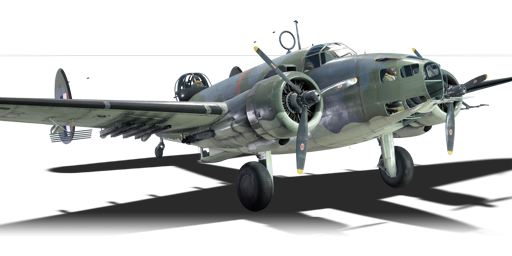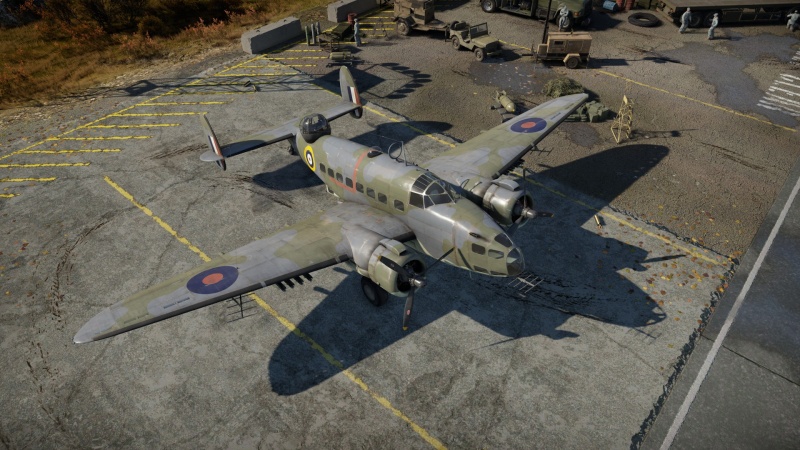Hudson Mk V (Great Britain)
Contents
Description
The Hudson Mk V was the designation given by Britain to the Lockheed Hudson V, an American-built light bomber designed for naval patrol, reconnaissance, and light bombing. It was based on the Lockheed Super Electra, a civilian airliner. The aircraft was very successful under British service, in total 2,150 Hudsons were used by the British Commonwealth through direct purchase and the Lend Lease program. They scored several kills against German submarines and were essential in maintaining the safety of Allied convoys in the Atlantic. After the war, some of those Hudsons served again as civilian airliners and transport aircraft.
It was introduced in Update 1.63 "Desert Hunters". For its BR, the Hudson MK.V is a relatively fast bomber, being able to go at a maximum speed of 418 km/h in realistic battles. This is very important, since you will most likely fight biplanes and early monoplanes with engines that are not well-suited for high altitude. This increased flight performance over its counterparts is balanced by the payload however; with only a small amount of 250 lb bombs and 8 x AP Mk.I rockets that don't have any explosive filler. For its defensive armament, it has good total coverage, but the usage of 7.7 mm MGs instead of more conventional 12.7 mm HMGs makes dealing with groups of enemies more challenging.
General info
Flight performance
Fast for its battle rating, the Hudson Mk V is a very versatile bomber, able to turn with some single-engine fighters and outrun any it may face.
| Characteristics | Max Speed (km/h at 1,981 m) |
Max altitude (metres) |
Turn time (seconds) |
Rate of climb (metres/second) |
Take-off run (metres) | |||
|---|---|---|---|---|---|---|---|---|
| AB | RB | AB | RB | AB | RB | |||
| Stock | 399 | 386 | 5029 | 27.3 | 27.8 | 6.9 | 6.9 | 600 |
| Upgraded | 437 | 418 | 24.8 | 26.0 | 15.0 | 9.5 | ||
Details
| Features | ||||
|---|---|---|---|---|
| Combat flaps | Take-off flaps | Landing flaps | Air brakes | Arrestor gear |
| ✓ | ✓ | ✓ | X | X |
| Limits | ||||||
|---|---|---|---|---|---|---|
| Wings (km/h) | Gear (km/h) | Flaps (km/h) | Max Static G | |||
| Combat | Take-off | Landing | + | - | ||
| 564 | 235 | 328 | 313 | 235 | ~8 | ~4 |
| Optimal velocities (km/h) | |||
|---|---|---|---|
| Ailerons | Rudder | Elevators | Radiator |
| < 260 | < 290 | < 320 | > 324 |
Survivability and armour
- No armour
- Self-sealing fuel tanks (2 in each wingroot)
Modifications and economy
Armaments
Offensive armament
The Hudson Mk V (Great Britain) is armed with:
- 2 x 7.7 mm Browning machine guns, nose-mounted (500 rpg = 1,000 total)
Suspended armament
The Hudson Mk V (Great Britain) can be outfitted with the following ordnance:
- 4 x 250 lb AN-M57 bombs + 6 x 100 lb AN-M30A1 bombs (1,600 lb total)
- 8 x AP Mk I rockets
- 4 x 250 lb AN-M57 bombs + 6 x 100 lb AN-M30A1 bombs + 8 x AP Mk I rockets (1,600 lb total)
Defensive armament
The Hudson Mk V (Great Britain) is defended by:
- 2 x 7.7 mm Browning machine guns, dorsal turret (1,000 rpg = 2,000 total)
- 1 x 7.7 mm Vickers K machine gun, ventral turret (500 rpg)
Usage in battles
The Hudson excels in ground attacking with its respectable payload of bombs, rockets and dual-mounted 7.7 mm - meaning it has a lot of firepower to throw at the ground units. It can also be used as a designated bomber, having a load big enough to take out one base and damage another. However in RB, you may find the Hudson to be best for bomber hunting and keeping the enemy fighters down as its fairly fast and manoeuvrable. To take on bombers, it is advisable to position yourself in front of or below an enemy bomber (wherever their firepower is weak) as the Hudson has no armour to protect the pilot. You can then light them up with the dual-mounted Browning 7.7s on the dorsal turret, which has a full 360° field of view and good elevation. Use AP belts to compensate for the relatively low calibre of the armament.
The Hudson is a hard target to take out, with three rear facing MG's being enough to take on most of what it will find at its BR. The Hudson's airframe is also able to withstand a fair amount of punishment. It also outperforms many aircraft it will face such as the early Bf 109s at high altitude, being able to even outrun some fighters at its BR with its cruising speed of over 350 km/h. Despite a lack of armour for the gunners, they seem to rarely get taken out - but it is advisable to keep fighters at bay from a fairly long range with your gunners as once they get close they can inflict serious damage. The Hudson almost never recover from engine fires either, which are almost always caused by fighters close on your tail - another incentive to keep them back.
Manual Engine Control
| MEC elements | ||||||
|---|---|---|---|---|---|---|
| Mixer | Pitch | Radiator | Supercharger | Turbocharger | ||
| Oil | Water | Type | ||||
| Controllable | Controllable Not auto controlled |
Controllable Auto control available |
Controllable Auto control available |
Separate | Controllable 2 gears |
Not controllable |
Pros and cons
Pros:
- Good defensive armament
- Can carry 8 rockets in addition to the internal bomb bay
- Internal bomb bay can accommodate 4 x 250 lb bombs and 6 x 100 lb bombs
- Can fly on one engine
- Fuselage soaks up a lot of punishment
- Forward-firing fixed guns means the ability to strafe soft targets (e.g. unarmoured vehicles, artillery, AA, etc)
- Very fast cruising and top speed for a bomber
- H-tail does not get in the way of the gunners
Cons:
- Controls lock quickly in a steep dive
- Flaps tear off easily above 330 km/h
- Rarely recovers from engine fires
- No armour protection for crew
History
The Hudson Mk V is a British designation for a variant of the Lockheed Hudson, an American-built light bomber and maritime reconnaissance aircraft of the Second World War. The aircraft was a military conversion of the Lockheed Super Electra civilian airliner, and is one of few civilian aircraft to be successfully converted into military aircraft. Great Britain purchased a total of 309 Hudson Mk Vs; these aircraft were used successfully as anti-submarine aircraft by the Royal Air Force (RAF) as well as the Royal Canadian Air Force (RCAF).
In 1937, Lockheed began advertising a conversion of their Model 14 Super Electra civilian airliner as a light bomber and maritime patrol aircraft: this immediately attracted the attention of the British Purchasing Commission, which sought to acquire the Hudson as a supplement to their existing Avro Anson maritime patrol aircraft. As a result, the British placed an order for 200 Hudson Mk I aircraft in 1938; the Mk Vs were acquired later on, and were essentially Hudson Mk IIIs fitted with new 1,200 hp Pratt & Whitney Twin Wasp radial engines.
In total, 2,150 Hudsons would be used by the British Commonwealth through both direct purchase and lend-lease. These aircraft would serve extensively as maritime patrol aircraft under the RAF and RCAF, scoring numerous kills against German submarines. Additionally, Hudsons were used to provide air cover during the Dunkirk evacuations. Following the cessation of hostilities at the end of WWII, many Hudsons were returned to civilian service, as transport aircraft, trainers and airliners. A total of 2,941 Hudsons were built for all air forces.
Media
- Skins
- Videos
See also
- Related development
External links
| Lockheed Corporation | |
|---|---|
| Fighters | XP-38G · P-38E · P-38G-1 · P-38J-15 · Bong's P-38J-15 · P-38K · P-38L-5-LO · YP-38 |
| Bombers | B-34 · PV-2D |
| Jet Fighters | F-80A-5 · F-80C-10 |
| F-104A · F-104C | |
| Strike Aircraft | F-117 |
| Export / License | A-29 · ▄Hudson Mk V |
| ␗P-38L-1 | |
| ␗F-104A · ▀F-104G · ␗F-104G · ▄F-104G · ▅F-104J · ▄F-104S | |
| The Lockheed Corporation merged with Martin Marietta Corporation in 1995 to form Lockheed Martin Corporation. | |
| See Also | SABCA · Mitsubishi Heavy Industries · Fiat Aviation |
| Britain bombers | |
|---|---|
| Torpedo | Swordfish Mk I · Swordfish Mk II · ▄Avenger Mk II |
| Dive | V-156-B1 |
| Hydroplanes | ▄Catalina Mk IIIa · Sunderland Mk IIIa · Sunderland Mk V |
| Light | Blenheim Mk IV · Beaufort Mk VIII · ▄Hudson Mk V · Brigand B 1 |
| Based on A20 | ▄Havoc Mk I · ▄Boston Mk I · ▄DB-7 |
| Hampden | Hampden Mk I · Hampden TB Mk I |
| Wellington | Wellington Mk Ic · Wellington Mk Ic/L · Wellington Mk III · Wellington Mk X |
| Halifax | Halifax B Mk IIIa |
| Stirling | Stirling B Mk I · Stirling B Mk III |
| Lancaster | Lancaster B Mk I · Lancaster B Mk III |
| Lincoln | Lincoln B Mk II |
| Shackleton | Shackleton MR.Mk.2 |
| Britain premium aircraft | |
|---|---|
| Fighters | Tuck's Gladiator Mk II · ▄Boomerang Mk I · ▄Boomerang Mk II · ▄D.520 |
| ▄Martlet Mk IV · ▄Corsair F Mk II · ▄Hellcat Mk II · ▄Thunderbolt Mk.1 · ▄Mustang Mk IA | |
| Hurricane Mk.I/L FAA M · Spitfire Mk.IIa Venture I · Spitfire F Mk IXc · Plagis' Spitfire LF Mk IXc · Spitfire F Mk XIVc · Prendergast's Spitfire FR Mk XIVe | |
| Typhoon Mk Ib · MB.5 | |
| Twin-engine fighters | Hornet Mk.I · Whirlwind P.9 |
| Jet fighters | Attacker FB.2 · Hunter FGA.9 · Lightning F.53 · Meteor F Mk.8 Reaper · Sea Vixen F.A.W. Mk.2 · F-4J(UK) Phantom II · ▄MiG-21 Bison |
| Strike aircraft | ▄Wirraway · Beaufighter Mk I (40-mm) · Wyvern S4 |
| Harrier GR.1 · Strikemaster Mk.88 | |
| Bombers | ▄Avenger Mk II · ▄Boston Mk I · ▄Catalina Mk IIIa · ▄DB-7 · ▄Havoc Mk I · ▄Hudson Mk V · Swordfish Mk II |





